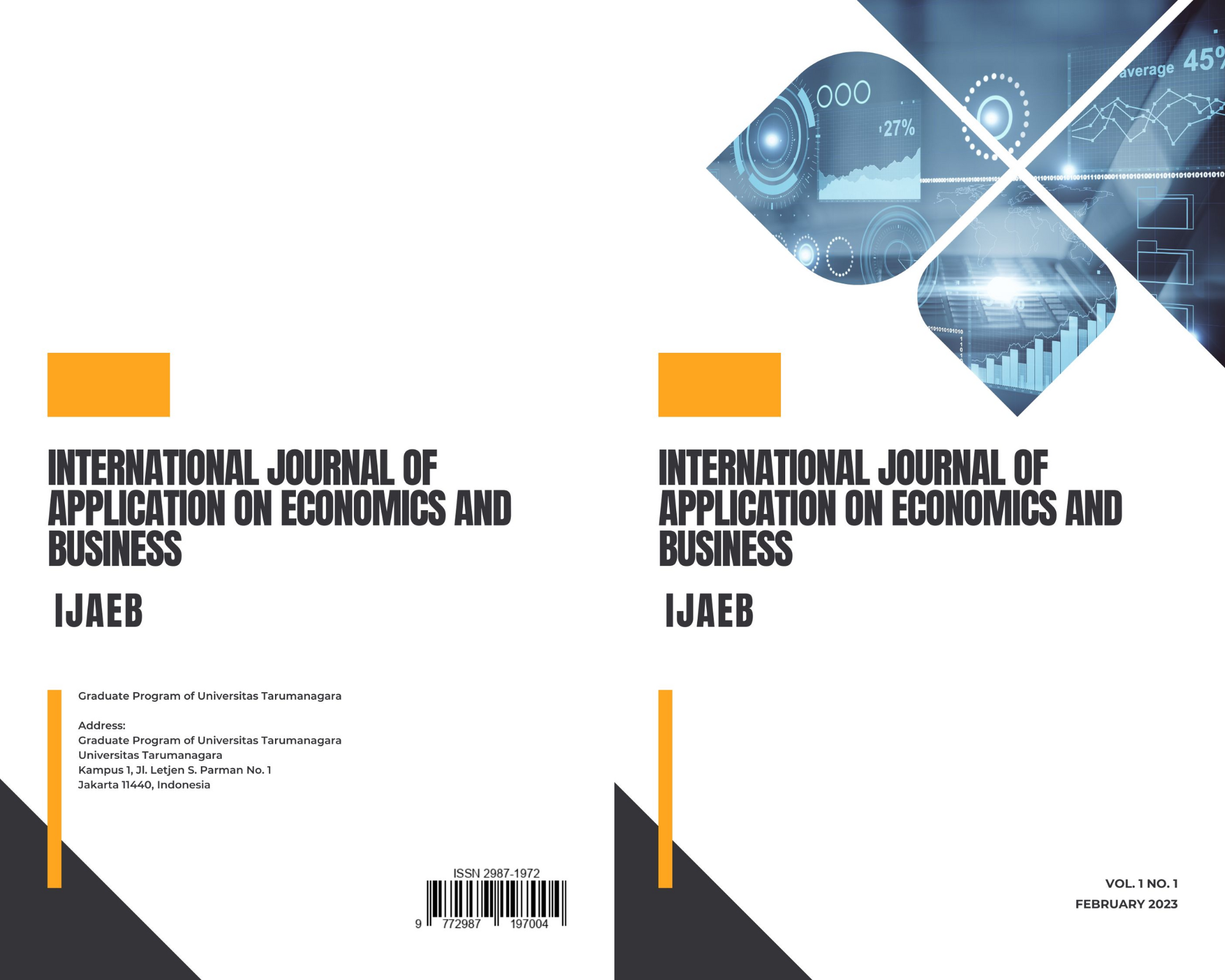The Effect of Inflation, Liquidity, and Capital Structure on Financial Performance of Consumer Goods Companies Listed on IDX
Main Article Content
Abstract
This study is intended to determine the empirical scientific evidence of the effect of inflation, liquidity, and capital structure on financial performance of consumer goods sector of companies listed on Indonesia Stock Exchange (IDX) in the period from 2016 to 2020. Financial performance is measured using ROE, while inflation is proxied by Indonesia’s annual inflation rate, liquidity is proxied by CR, and capital structure is proxied by DER. A total of 40 consumer goods companies were sampled in this research. The sample was selected using purposive sampling technique and resulted in a total of 200 observations. Data analysis was carried out using panel data regression using EViews 12 software. The results showed that inflation had a positive and significant effect on financial performance, liquidity had a negative and insignificant effect on financial performance, and capital structure had a positive and significant influence on financial performance of consumer goods companies listed on IDX.
Article Details

This work is licensed under a Creative Commons Attribution-NonCommercial-ShareAlike 4.0 International License.
This journal provides immediate open access to its content on the principle that making research freely available to the public supports a greater global exchange of knowledge.
IJAEB by Graduate Program of Universitas Tarumanagara is licensed under a Creative Commons Attribution-NonCommercial-ShareAlike 4.0 International License.. Permissions beyond the scope of this license may be available at https://journal.untar.ac.id/index.php/ijaeb
References
K. Natsir and Y. Yusbardini, “The Effect of Capital Structure and Firm Size on Firm Value Through Profitability as Intervening Variable,” vol. 145, no. Icebm 2019, pp. 218–224, 2020, doi: 10.2991/aebmr.k.200626.040.
A. Hidayat, “Sektor Industri Consumer Goods Masih Optimistis Tumbuh Di Tengah Ancaman Virus Corona,” industri.kontan.co.id, 2020. .
OJK, “Statistik Mingguan Pasar Modal 2020,” 2020.
H. P. Saragih, “Terungkap, Ini Penyebab Resesi Ekonomi Global,” CNBC Indonesia, 2019. .
C. D. Oleka, E. A. Sabina, and M. I. Ebue, “Relationship Between Inflation and Firms’ Performance-Evidence from Nigeria,” World Appl. Sci. J., vol. 33, no. 5, pp. 814–822, 2015, doi: 10.5829/idosi.wasj.2015.33.05.14584.
W. A. Khan, M. Shahid, R. Bari, W. Anam, N. Shehzad, and S. Siddique, “Impacts of Inflationary Trends on Banks’ Performance(Large Banks Segment) in Pakistan,” Int. J. Account. Financ. Report., vol. 4, no. 1, p. 296, 2014, doi: 10.5296/ijafr.v4i1.6083.
P. S. Nugraha and A. M. Haryanto, “Analisis Pengaruh Sales Growth, ROE, SIZE, TATO, dan Current Ratio Terhadap ROA dan Terhadap Beta Akuntasi Studi Kasus Pada Perusahaan Manufaktur yang Terdaftar di BEI Periode 2010-2014),” Diponegoro J. Manag., vol. 5, no. 1, pp. 1–12, 2016.
J. Jaworski and L. Czerwonka, “Relationship Between Profitability and Liquidity of Enterprises Listed on Warsaw Stock Exchange,” 35th Int. Sci. Conf. Econ. Soc. Dev. – "Sustainability from an Econ. Soc. Perspect., pp. 326–334, 2018.
D. Kartikaningsih, “PENGARUH DEBT RASIO, CURRENT RASIO, TOTAL ASSETS TURNOVER, SIZE PERUSAHAAN, DAN NET PROFIT MARGIN TERHADAP RETURN ON EQUITY (Studi Kasus Pada Perusahaan Manufaktur Yang Terdaftar Di Bursa Efek Indonesia Pada Tahun 2009-2011),” J. Akunt., vol. 1, 2013, doi: 10.24964/ja.v1i2.17.
E. Fransisca and I. Widjaja, “Pengaruh Leverage, Pertumbuhan Penjualan Dan Ukuran Perusahaan Terhadap Profitabilitas,” E-Jurnal Manaj. Univ. Udayana, vol. 4, no. 7, p. 249411, 2019.
M. Latha and S. N. Rao, “Determinants of profitability: Evidence from listed companies in the bse-fmcg,” Int. J. Econ. Perspect., vol. 11, no. 3, pp. 1264–1272, 2017.
M. C. Novyanny and J. A. Turangan, “Pengaruh Likuiditas, Ukuran Perusahaan, Umur Perusahaan dan Pertumbuhan Perusahaan Terhadap Profitabilitas Pada Perusahaan Jasa Terdaftar Pada Bursa Efek Indonesia,” J. Manag. Stud., vol. 4, no. 1, pp. 66–78, 2017.
A. S. Alarussi and S. M. Alhaderi, “Factors affecting profitability in Malaysia,” J. Econ. Stud., vol. 45, no. 3, pp. 442–458, 2018, doi: 10.1108/JES-05-2017-0124.
A. R. Anissa, “Pengaruh Perputaran Modal Kerja, Pertumbuhan Penjualan, dan Likuiditas terhadap Profitabilitas pada Perusahaan Retail yang Terdaftar di Bursa Efek Indonesia,” Maj. Sainstekes, vol. 6, no. 2, pp. 125–145, 2019, doi: 10.33476/ms.v6i2.1197.
M. R. Ebrati, F. Emadi, R. S. Balasang, and G. Safari, “The Impact of Capital Structure on Firm Performance: Evidence from Tehran Stock Exchange,” Aust. J. Basic Appl. Sci., vol. 7, no. 4, pp. 1–8, 2013.
D. X. Quang and W. Z. Xin, “Measuring Impact of Capital Structure on Financial Performance of Vietnamese Soes,” Innov. J. Bus. Manag., vol. 4, no. 6, pp. 114–117, 2015.
Romadhoni and H. Sunaryo, “Pengaruh Struktur Modal Terhadap Kinerja Keuangan Perusahaan Manufaktur Sektor Makanan dan Minuman Yang Terdaftar di Bursa Efek Indonesia 2013-2016,” vol. 6, no. 6, pp. 219–232, 2017.
Nassar, “The Impact of Capital Structure on Financial Performance of the Firms: Evidence From Borsa Istanbul,” J. Bus. Financ. Aff., vol. 5, no. 2, pp. 2–6, 2016, doi: 10.4172/2167-0234.1000173.
Nini and D. Patrisia, “Pengaruh Struktur Modal Terhadap Kinerja Keuangan Perusahaan the Effect of Capital Structure on the Firm,” no. 2012, 2019, doi: 10.21831/economia.v16i2.30661.
J. Hartono, Teori Portofolio dan Analisis Investasi, Sebelas. Yogyakarta: BPFE, 2013.
Rudianto, Akuntansi Manajemen Informasi untuk Pengambilan Keputusan Strategis. Jakarta: Erlangga, 2013.
BPS, “No Title,” 2021. .
Kasmir, Analisis Laporan Keuangan. Jakarta: Raja Grafindo Persada, 2008.
I. Fahmi, Analisis Laporan Keuangan. Bandung, 2017.
L. J. Gitman and C. J. Zutter, Principles of Managerial Finance, 14th ed. Harlow: Pearson Education, 2015.
J. C. Van Horne and J. M. Wachowicz, Prinsip-Prinsip Manajemen Keuangan. Jakarta: Salemba Empat, 2012.
S. A. Ross, R. W. Westerfield, J. Jaffe, and B. D. Jordan, Corporate Finance, 11th ed. New York: McGraw Hill Education, 2016.
A. Mirza, “Determinants of financial performance of a firm: Case of Pakistani stock market,” J. Econ. Int. Financ., vol. 5, no. 2, pp. 43–52, 2013, doi: 10.5897/jeif12.043.
S. Vătavu, “The Impact of Capital Structure on Financial Performance in Romanian Listed Companies,” Procedia Econ. Financ., vol. 32, no. 15, pp. 1314–1322, 2015, doi: 10.1016/s2212-5671(15)01508-7.



